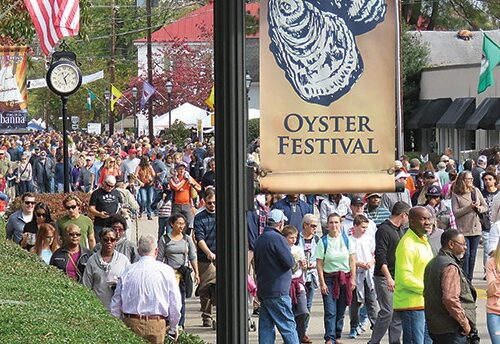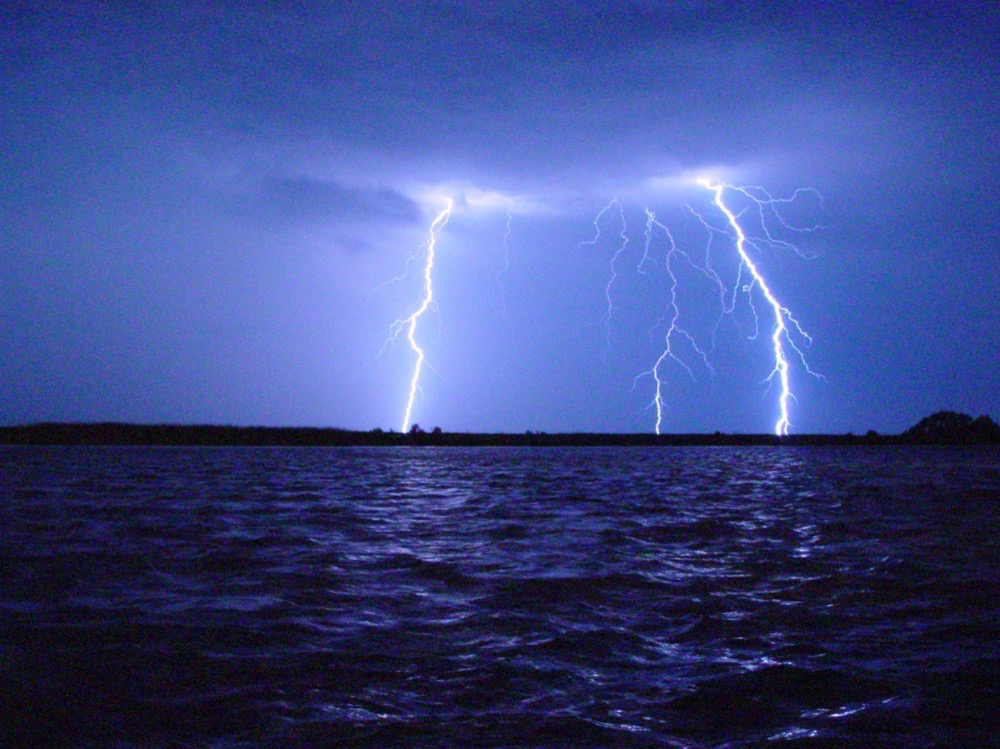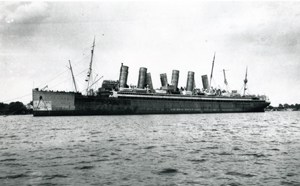by Gary Reich
A glassy calm settles across the Chesapeake Bay as Officer First Class Chris Leville lays down the throttles on his patrol craft, simultaneously stoking the coals inside the two large diesel engines buried deep inside the boat’s belly. Leville scans the horizon of the seemingly empty, flat, mid-winter scene off Sandy Point State Park, eventually spotting a small flotilla of deadrise workboats many miles to the southeast. To untrained eyes, the boats appear simply as seagulls bobbing about on the water’s surface.
Arriving on scene, Leville gingerly bellies his patrol boat up against Foolish Pleasure, a stout but graceful deadrise workboat. Her crew of three are busy shaking free hundreds of pounds of white perch clogging their gill nets. Once Leville and Officer Antonio Colvin are aboard, net sizes and floats are checked, the catch size is scrutinized, commercial fishing licenses are examined, and safety gear and required placards are inspected. Having passed the officers’ detailed examination, Foolish Pleasure casts off and resumes fishing. “All in a day’s work,” Leville says, pointing us toward another commercial fishing boat on the horizon.
This scene repeats many hundreds of times each day across Maryland’s Chesapeake Bay, as Maryland Natural Resources Police’s (NRP) 262 sworn officers inspect commercial boats to ensure their skippers are sticking to the rules. But these officers’ jobs and the mission of the organization they work for entails much more. These law enforcers are also lifesavers, environmental stewards, conservationists, wildlife rescuers, crime solvers, and even protectors of the homeland—despite the impression among many that these officers are simple game wardens. Given the seemingly common yet inaccurate assessment of the NRP’s mission, I set about spending a year riding along with a handful of NRP officers to get a feel for what really makes the organization and its officers tick. The following is the story of our time together.
Summertime Blues
It’s an oppressively humid and hazy Friday night on 17-year NRP veteran Master Officer Norris Shannon’s Potomac River beat, which also includes the surrounding Maryland counties. The river is loaded with recreational boaters as the weekend gets underway. Shannon departs from Fort Washington Marina, carving a path upriver in his Boston Whaler patrol craft. Suddenly, an express cruiser blasts through the haze ahead of him at high speed. “See those two people up on the bow?” Shannon asks. “That’s no good; let’s make contact with them and see what they’re up to this afternoon.” Shannon flips on the blue lights, swivels the boat around and makes chase.
As we come alongside, Shannon explains to the skipper that the two people up on the bow will have to come down. “How’s it going this evening? Just so you know, they can’t ride up there while you’re underway,” he says, adding, “I’ll need to see your registration and driver’s license, and let’s have a look at your safety gear.” Once Shannon has confirmed the presence of obligatory personal flotation devices, day/night signals, and a sound-making device, he asks the skipper to stay put as we push off to check his license and boat registration details.

These routine stops are not just an effective way for officers to make sure a vessel is equipped with the required safety gear, they’re also a useful way to nab skippers under the influence of drugs or alcohol, or apprehend individuals with outstanding arrest warrants. Shannon’s check of this skipper’s credentials comes back clean, so he writes a warning citation and sends the boat on its way. “Have a safe evening, Cap’n.”
Shannon likes to use the stops as opportunities to educate the boating public rather than antagonize them. “Those folks likely had no idea how dangerous bow riding can be, so it’s good to use our stops as a time to coach boaters on how to be safer on the water,” Shannon says. “I like to use this as an opportunity instead of aggressively lecturing a skipper.”
Patrolling some 17,000 miles of waterways, NRP officers in 2016 made contact with 153,896 recreational and commercial vessels. That’s almost 422 contacts a day, on average, statewide. NRP is also responsible for policing state lands, enforcing fishing and hunting laws, providing search and rescue support, protecting sensitive areas, rescuing wildlife, and even writing traffic tickets. Last year, NRP interacted with 17,243 hunters and 90,100 people on public lands—a whopping 480,000 acres of land, to be exact. The enormity of that math can take a toll on officers already stretched to the limits. “Keeping a balance between running my beat on the water and monitoring shoreside areas can be challenging,” Shannon says. “But it’s that mix of responsibilities that makes the job so enjoyable.”
Under the Influence
Shannon, a retired Marine and father of three with a build that resembles an NFL running back, has a calm but firm demeanor, and he is enjoyable to talk with. He would find his pleasant disposition tested as he continues his evening patrol. Motoring up the Potomac River toward Washington, D.C., Shannon notices a large express-style motoryacht packed with about 25 occupants. The boat was leaving National Harbor, an expansive development peppered with hotels, restaurants, and bars. Eyeing the motoryacht’s helm as we pass by, Shannon picks up on a skipper swap that would go unnoticed by most. “Something’s not right there,” Shannon says. “People often trade driving positions like that when someone’s been drinking, and this is a hot spot for operators under the influence.” Keeping his eyes on the person who evacuated the helm position, Shannon turns on the blue lights and signals the large Sea Ray to stop.

Smelling alcohol on the skipper and noticing his unstable movements, Shannon gives the operator a series of preliminary field sobriety tests on the stern. A few minutes later Shannon takes the skipper into custody and loads him aboard his patrol craft. “I hope you don’t have any plans tonight,” Shannon jokingly says to me. “This could take a while.” Under state law, Shannon must take the operator ashore and allow him to acclimate to land for a prescribed period. Only then can he administer further sobriety tests to assess his ability to operate a vessel. While Shannon is ashore, I kick back on one of the patrol boat’s seats, the scene lit aglow from the neon lights beaming down from the massive development. Soon, I hear Shannon’s voice, broken by loud static, booming over the boat’s police radio. He’s trying to muster a “breath tech,” a person who can administer his suspect an accurate breathalyzer that could be admissible in court. Not able to find one and with time running out on the sobriety clock, Shannon loads the skipper back on the boat and writes him a warning ticket. “You could have gone to jail tonight,” he says. “Worst of all, you could have seriously injured or killed one of your friends on your boat or someone else on the water. Consider this a very lucky learning experience.”
“Too much time had passed by the time I got him ashore, administered the sobriety tests, and radioed around trying to find a breath tech. It happens, and it’s frustrating, but I had to set him loose with a warning,” Shannon says.
Natural Resources Police officers issued 264 citations statewide last year for skippers operating vessels under the influence, also known as an “OUI.”
Shannon says, “To get a conviction requires the stars to align in just the right way. There are a number of pieces to the evidence-gathering puzzle, and time is always against us. We do the best we can. It’s annoying when we have to warn someone versus citing them, though.”
Shannon’s patrol boat glides back into her slip a little after 11 p.m., a foggy haze settling over the marina. “It was nice riding with you tonight,” Shannon says. “I’ve still got a couple of hours’ worth of planning work for our tactical team,” he adds, waving as he drives off into the summer darkness in his patrol truck.
Protecting the Homeland
In addition to the plethora of other responsibilities, some NRP officers train with the organization’s tactical team, where Shannon has a leadership role. The team’s aim is to enforce maritime laws, protect homeland and port security, and a provide other specialized services. It’s a team that benefits from officers with military experience like Shannon who says, “It’s a good fit that benefits from my time in the Marines and I really enjoy training with the other officers. There’s definitely a special camaraderie there. It adds a unique mix to my job.”
Months later, NRP officers are on the Severn River performing a homeland security check of the U.S. Naval Academy’s bulkhead. Aboard are Officer First Class Kristen McFarland, Officer First Class Chris Leville and Officer Antonio Colvin.

“We try to check this area, the Bay bridges, and other sensitive areas on each patrol,” says Colvin, who is a new recruit, fresh from NRP’s training academy. It was NRP’s largest graduating class, with 27 graduates. Colvin works alongside Leville for four weeks, part of his 12-week training period. “I used to run a car valet service,” he says, “This is a big change for me, but I’m really excited about my new career.”
There is an armada of recreational fishing boats scattered about the base of the twin Chesapeake Bay Bridge spans, jigging for wintering rockfish. The officers approach one with a lone angler aboard skillfully jigging his fishing rod. We drop Colvin aboard. The angler seemingly ignores the fact that he’s got an officer aboard, continuing to work his jig in the active currents around the bridge supports. He turns around to Colvin and puts his finger over his mouth. “Shhhh… I’ve been playing around with this one fish for an hour,” he says. “Go ahead and check all the compartments and I’ll get my safety gear out after this last cast.” Colvin chuckles, confirms the angler isn’t hiding any rockfish in his holds, checks his safety gear, and then lets the angler continue trying to fool the solitary fish.
“You can’t keep rockfish this time of year,” Colvin says. “That’s why we check bilges and holds. We’re responsible for aiding in the conservation and enforcement of a number of different fisheries and hunting seasons. In the summer, we’re checking recreational and commercial crabbers most frequently while in the winter we’re focused mostly on commercial gill net and oyster fisheries. We’re also very active in policing waterfowl and deer hunting seasons during the winter months.”
Regardless of the season, officers often find it challenging to cover their beats effectively, given the vast expanses of water and land they’re responsible for. The agency focused on addressing this issue in late 2010 by bringing its Maritime Law Enforcement Information Network (MLEIN) online. The network consists of an array of radar and camera installations around Maryland’s Chesapeake Bay that is capable of tracking suspicious vessels as well as aiding in search and rescue operations. Though critics liken the network to a dystopian example of big brother surveillance, the system catches poachers and saves lives.
For example, officers can draw geo-fences around oyster sanctuaries and be alerted when a vessel traipses into areas that are off-limits to harvest. The system caught two poachers doing just that in Tangier Sound in early 2015, as NRP officers used the system to track a vessel sneak into an oyster sanctuary under the cover of a dense fog. Officers were able to approach the poachers without being detected, which allowed them to witness the illegal activity. “It gives us opportunities we wouldn’t normally have without it,” says agency veteran Lieutenant Roy Rafter. “We can also use it to aid in search and rescue. All those cameras give us a keen eye on busy boating areas and can help us pinpoint the location of a vessel in distress.” The system has continued to prove its effectiveness at nabbing oyster poachers and aiding in many additional convictions over the years.
First Responders
Search and rescue makes up another swath of responsibility for NRP officers. When things go horribly wrong, NRP officers are often first responders, and they save many lives each year. Boating-related deaths unfortunately are also part of the mix, and NRP is the go-to organization when a rescue operation shifts to a recovery mission. There’s an extensive NRP dive team that aids in such instances. Seventeen people lost their lives in boating-related accidents in Maryland in 2016. All but a few weren’t wearing lifejackets. “So many of these incidents could potentially end with happier endings,” Officer First Class Kristen McFarland says. “It’s frustrating when something so seemingly preventable takes an individual’s life. Dealing with those events is one of the more difficult aspects of the job.”
Leville throttles back as he runs alongside a long rock-strewn fishing jetty, working his way back toward the NRP dock at Sandy Point State Park, where he and the other officers plan to call it a day. “This is a good job for the right person,” Leville says. “You’ve got lots of independence, and we really do make a difference out here. There’s an opportunity during every shift to do something good, learn something new, help conserve the Bay’s resources, and to protect and serve the boating public.” Based on what I witnessed over the last year, Leville isn’t exaggerating. Seeing firsthand what the NRP does on a daily basis would make anyone who actively uses Maryland’s outdoors glad its officers are there, day and night, 24/7.

Gary Reich is a Chesapeake Bay-based freelance writer, photojournalist and CBM editor-at-large. He is an avid birdwatcher and angler who enjoys a fresh, plump oyster whenever he can.



